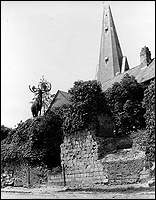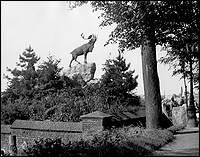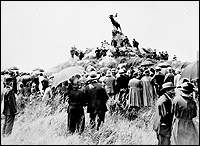|


|

|

Commemorations Overseas
In July 1919, the government appointed Lieutenant-Colonel Father Thomas Nangle, the former
Roman Catholic Padre of the regiment, as Newfoundland’s representative on the Imperial War
Graves Commission. The government gave Nangle “unlimited authority to do what [he] thought
was right” (Nangle, “Newfoundland” 7).
Nangle supervised the exhumation of known graves, the construction of Newfoundland’s 15 war
graveyards, and the building of five memorials. He viewed memorials as “monuments to our
glorious dead, and to our just as glorious survivors. They are monuments to the mothers that bore
such brave sons and the land that bred them. They are to be an everlasting tribute to the men who
gave their all that the land may live.” Nangle went on to suggest that “Anything under £1000 in
France per monument would be unworthy . . . of the Regiment” (Nangle, “Preliminary” 9–10).
Sixteen memorial designs were submitted to Nangle. He recommended that the government
accept British sculptor Captain Basil Gotto’s plan to erect five identical caribou statues in memory of the
regiment. Gotto’s “proposition [is] much cheaper than any of the others, it [is] artistic . . . [and]
most distinctive, his idea being a giant caribou somewhat like the ‘monarch of the Topsails’ carved
in bronze on a rough cairn of Newfoundland granite about ten to fifteen feet high.” The design
was “distinctive of the regiment and Newfoundland. It [is] artistic and cheap, all five being cast
from the same mould” (Nangle, “Second” 11–12).
Newfoundland War Memorial, Monchy-Le-Preux, France, n.d.
Courtesy of the Provincial Archives of Newfoundland and Labrador (PANL B-1-84), St. John’s,
Newfoundland.
 (54 Kb)
(54 Kb)
|
 |

|
Five memorials were constructed in Europe—one in Courtrai, Belgium and four others in
France, at Marcoign Masnières, Gueudecourt, Monchy-Le-Preux and Beaumont Hamel. The help
of landscape architect R.H.K. Cochius was enlisted to design them. The cost was approximately
£1,000 ($35,000) each. At each site a bronze caribou overlooked the battlefield where
Newfoundlanders had fought and died.

|
 |
Newfoundland War Memorial, Courtrai, Belgium, n.d.
Courtesy of the Provincial Archives of Newfoundland and Labrador (PANL B-1-87), St. John’s,
Newfoundland.
 (60 Kb)
(60 Kb)
|
The best-known memorial was, and is, the Beaumont Hamel Memorial Park in France. Cochius
(the designer of Bowring Park in St. John’s) was determined that the Newfoundland memorial
would rank with the memorial parks of the other nations in the British Empire, and would not
“stand behind Vimy-Ridge Park [Canada] or Delville-Wood [South Africa] . . . ” While
Newfoundland could not afford to spend extravagant sums of money, Beaumont Hamel
became, as Cochius wished, “the only place along the whole front where part of the
battlefield [was] . . . preserved” (Cochius 18–19). Everywhere else the battlefields were recultivated
and a shattered landscape restored. Beaumont Hamel, in that sense, is unique as a memorial.
Opening of Beaumont Hamel Park, France, ca. 1925.
Courtesy of the Provincial Archives of Newfoundland and Labrador (PANL NA-31-06), St. John’s,
Newfoundland.
 (41 Kb)
(41 Kb)
|
 |

|
It was decided to import many of Newfoundland’s native trees, such as spruce, dogberry and
juniper, to plant along the boundaries near the entrance. In total, over 5,000 trees
were transplanted before the project was finished. The work on the
park was completed in 1925 and on June 7, Field-Marshal Haig was present at the unveiling.
The opening ceremony was an elaborate affair. Each of the units of the 29th Division sent
representatives for the honour guard, and there were many distinguished guests. Haig solemnly
described the unveiling of the memorial as an occasion that would “remind generations still
unborn of the loyalty and courage of Newfoundland men and of the unity and strength of the
mighty Empire which [is] our pride and our inheritance . . . ” He went on to
state that although July 1, 1916, caused much sorrow in Newfoundland, “the story of the
gallant men who fell before Beaumont Hamel, to gain objectives which no courage or self-sacrificing
were able to hold, [would] be an inspiration to their fellow countrymen for all
time . . . ” (Nangle, “Newfoundland” 9).
Haig recognized that Beaumont Hamel was representative of the Newfoundland spirit. Nangle
believed that “if Beaumont Hamel [was] preserved with reasonable attention it [would] remain not
only a great tribute to the force of Newfoundland, but [would] also go down to posterity as the
greatest historical memorial of what the Great War actually meant” (Nangle, “Newfoundland”
14). Both men were right. Beaumont Hamel has typified the spirit of Newfoundland while the
monument became its lasting testimonial.

|

|
 |